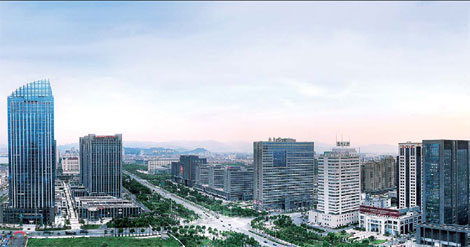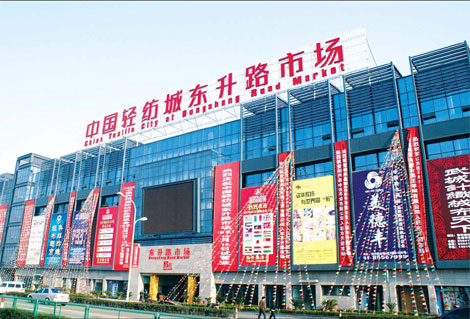China Textile City alters fabric of the industry
Updated: 2011-10-18 08:09
By Zhao Bian (China Daily)
|
|||||||||||
|
Home to headquarters and representative offices of many domestic and international companies, China Textile City is now Keqiao's central business district. Photos provided to China Daily |
|
With floor space covering 3.2 million square meters, China Textile City is the world's largest trading hub for the industry. |
Mention of the booming commodity trade in Zhejiang province usually evokes images of Yiwu, where dealers can search for every kind of small commodity imaginable.
But insiders in the textile industry from both home and abroad first think of China Textile City in Shaoxing county, and with good reason - it is the largest textile distribution hub in the world.
Its rapid development has already attracted the attention of economists. Before they talked of the "Yiwu growth mode". Today that has been replaced with the "China Textile City model".
The media have joined to make comparisons between the two Zhejiang output giants with statistics such as transaction volumes.
Zhou Rusheng, head of the administration committee at China Textile City, has repeatedly declined to answer media questions about whether the facility's transaction value has surpassed Yiwu.
But he noted "we had 14,000 points of sale in the textile city in June".
"Transaction volume through those sites in the first six months already surpassed the total amount last year."
Zhou said he does not care only about transaction volume anyway, adding: "I agree with economists who say developing a sustainable growth mode is more important."
In the past two years, the administrative committee invited experts from a number of local universities and research institutes including prestigious Zhejiang University to help China Textile City find an effective model for rapid and sustainable growth.
Zhou also led his management team to visit major textile trading markets in Jiangsu, Anhui, Shandong and Guangdong provinces in recent years.
"Wholesaling businesses in these regions were flourishing five years ago," Zhou said. "But none of them can sustain the growth today."
In contrast, China Textile City welcomed visitors from these areas in recent years who were amazed at the continuing expansion of the world's largest textile distribution center.
Extended value chain
But behind China Textile City's sustained prosperity is not just expansion of its business scale, but extension of the entire value chain, Zhou said.
In September, construction on a 100,000-square-meter textile plant by Fenghuangzhuang Co was completed in Keqiao.
He Xihui is the boss and founder of Fenghuangzhuang, which was started in 1998 with an initial investment of 40,000 yuan. The company long focused on textile wholesaling.
"Selling cloth and fabrics is still very profitable," He said, adding that "last year our 14 subsidiary firms reported a combined revenue of 1 billion yuan."
He noted that his company has maintained a more than 60 percent year-on-year growth for four years.
But he was still not satisfied.
At the very beginning of the global financial crisis in 2008, He foresaw that trading was most vulnerable to an economic downturn.
In that year, he made a bold decision to invest 200 million yuan to build a manufacturing center.
In addition to production, it is also a facility for trading, warehousing, logistics, research and development, quality supervision, design and training - covering most of the entire value chain in the industry.
He's ambitious plans include an advanced fabrics testing center to offer the strictest checks on all products made by the company and the Fenghuangzhuang Academy to train researchers and technicians.
He also plans to employ top designers from Australia to help promote the company's production internationally.
"We are not only a trading company now," He said.
Zhou Rusheng noted it "is also the direction of the China Textile City's development".
'Created in Keqiao'
"We are in a process of evolving from 'sold from Keqiao' to 'made in Keqiao' and eventually to 'created in Keqiao'," Zhou said.
The administration committee has also invited famous designers from home and abroad to open design and consulting firms in China Textile City to help local enterprises develop high-value-added products.
Zhou expects the introduction of outside influences can help foster famous brands among local enterprises.
Shaoxing and China Textile City already have domestically renowned brands like Honghuanglan, Dingji and Shaozhou.
But local authorities hope to elevate them further onto the international market.
While consolidating trading facilities in China Textile City, the administration committee is also making heavy investment in support businesses such as warehousing, logistics, exhibitions, transportation and e-commerce.
Since 2005, the total floor space of all trading facilities at China Textile City has increased from 1.1 million square meters to today's 3.26 million square meters.
In 2010, the number of registered companies and firms reached 19,629, increasing 150 percent from 2005.
At the same time the floor space of such supporting facilities as warehousing, logistics, exhibition, testing and R&D totaled 510,000 square meters.
In addition, there are 155 transportation companies responsible for shipping 2 million tons of cargo annually.
In July 2011, a test center for the China National Textile and Apparel Council was established in China Textile City, the largest textile testing lab in Zhejiang, which offers a range of services to local enterprises.
But the most important move this year is the online textile city project, the biggest e-commerce platform in the international textile industry.
Extending the supply chain is also an important part of the value chain in the industry.
The twice-a-year China Keqiao International Textile Expo has made a great contribution because it brings thousands of suppliers from home and abroad to Shaoxing.
In addition, China Textile City has also signed partnership agreements with the major textile producing areas in Jiangsu, Shandong and Guangdong, ensuring smooth cargo flow into Shaoxing.
Global hub
At present, more than 220 foreign textile companies have branches and representative offices in China Textile City. And more than 100 local companies have opened sales networks in foreign countries.
The town of Keqiao is the county seat of Shaoxing, an area that has been noted for its textiles stretching all the way back to the Spring and Autumn Period (770-476 BC) of China's history.
Textiles are still Shaoxing's pillar industry with more than 10,000 companies or firms and over 200,000 people are engaged in the production of textile products.
In recent years, the county's textile industry has generated total revenue surpassing 100 billion yuan annually.
China Textile City in Keqiao was first built in the 1980s and expanded several times in the years following. It is now the world's largest distribution center for textile products, accounting for one-fourth of global transactions in textile materials and fabrics.
The facility now has 3.2 million square meters of floor space that houses more than 20,000 trading companies and firms, including representative offices and branches of overseas businesses.
(China Daily 10/18/2011 page18)

